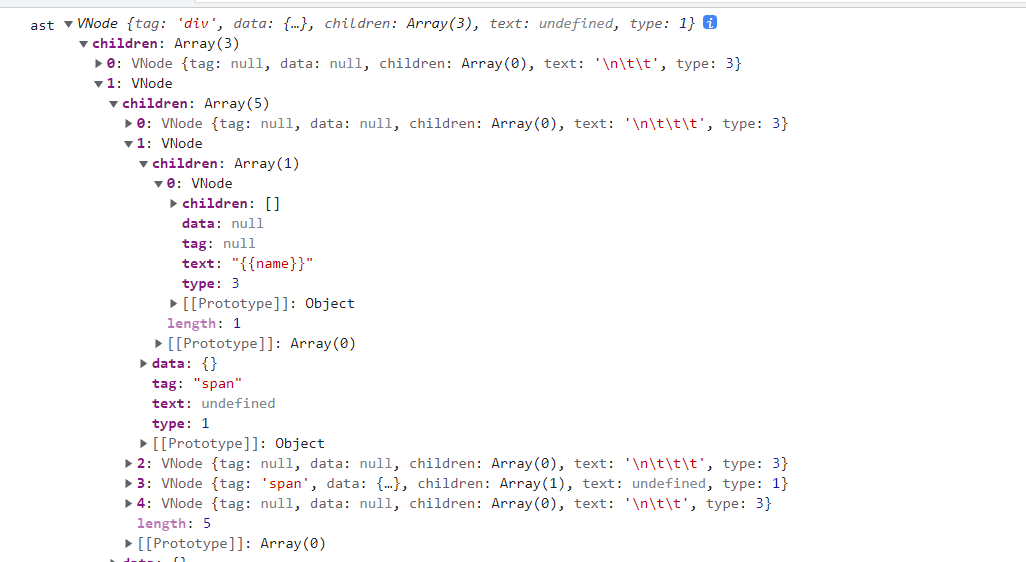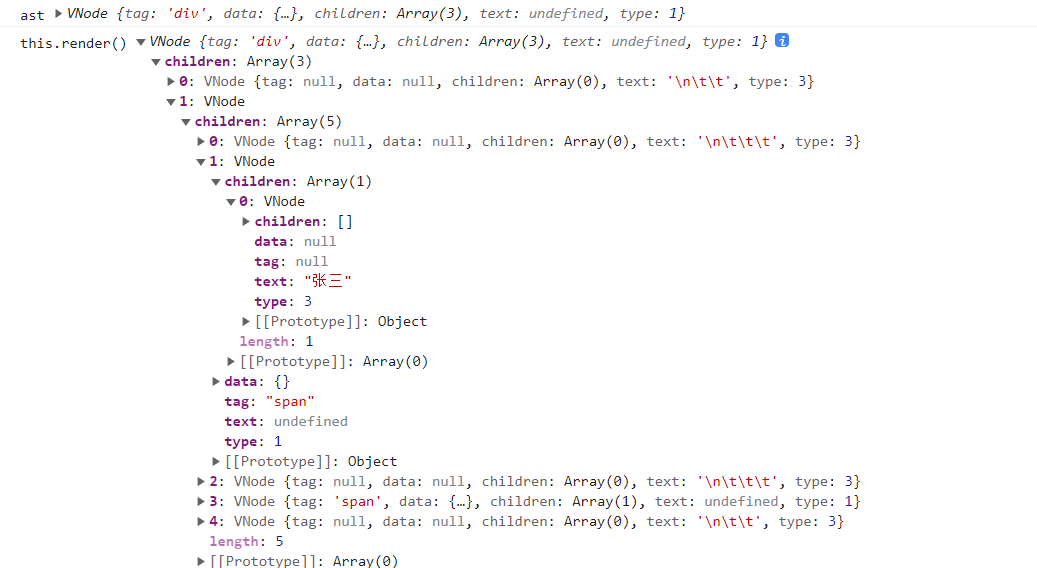1
2
3
4
5
6
7
8
9
10
11
12
13
14
15
16
17
18
19
20
21
22
23
24
25
26
27
28
29
30
31
32
33
34
35
36
37
38
39
40
41
42
43
44
45
46
47
48
49
50
51
52
53
54
55
56
57
58
59
60
61
62
63
64
65
66
67
68
69
70
71
72
73
74
75
76
77
78
79
80
81
82
83
84
85
86
87
88
89
90
91
92
93
94
95
96
97
98
99
100
101
102
103
104
105
106
107
108
109
110
111
112
113
114
115
116
117
118
119
120
121
122
123
124
125
126
127
128
129
130
131
132
133
134
135
136
137
138
139
140
141
142
143
144
145
146
147
| <!DOCTYPE html>
<html lang="en">
<head>
<meta charset="UTF-8">
<meta http-equiv="X-UA-Compatible" content="IE=edge">
<meta name="viewport" content="width=device-width, initial-scale=1.0">
<title>LikeVue</title>
</head>
<body>
<div id="root">
<div>
<span>{{name}}</span>
<span>{{age}}</span>
</div>
</div>
<script>
class VNode{
constructor(tag, data, children, text, type) {
this.tag = tag && tag.toLowerCase();
this.data = data;
this.children = [];
this.text = text;
this.type = type;
}
appendChild(vnode) {
this.children.push(vnode);
}
}
function createVNode(node) {
let nodeType = node.nodeType;
let _vnode = null;
if(nodeType === 1){
let _attrObj = {};
for(let i = 0; i < node.attributes.length; i++){
_attrObj[node.attributes[i].name] = node.attributes[i].value;
}
_vnode = new VNode(node.tagName, _attrObj, [], undefined, nodeType);
for(let i = 0; i < node.childNodes.length; i++){
_vnode.appendChild(createVNode(node.childNodes[i]));
}
}else if(nodeType === 3){
_vnode = new VNode(null, null, null, node.textContent, nodeType);
}
return _vnode;
}
function parseVNode(vnode) {
let nodeType = vnode.type;
let _node = null;
if(nodeType === 1){
_node = document.createElement(vnode.tag);
for(let key in vnode.data){
_node.setAttribute(key, vnode.data[key]);
}
for(let i = 0; i < vnode.children.length; i++){
_node.appendChild(parseVNode(vnode.children[i]));
}
}else if(nodeType === 3){
_node = document.createTextNode(vnode.text);
}
return _node;
}
function LikeVue(options) {
this._data = options.data;
this.$el = document.querySelector(options.el);
this._template = options.el;
this._parent = this.$el.parentNode;
this.mount();
}
LikeVue.prototype.getPropByPath = function (obj, path){
return path.split('.').reduce((acc, cur) => acc[cur], obj);
}
LikeVue.prototype.combine = function (tmpNode, data) {
let rPattern = /\{\{(.*?)\}\}/g;
let _type = tmpNode.type;
let _tag = tmpNode.tag;
let _data = tmpNode.data;
let _text = tmpNode.text;
let _children = tmpNode.children;
let _vnode = null;
if(_type === 1){
_vnode = new VNode(_tag, _data, [], _text, _type);
_children.forEach(element => _vnode.appendChild(this.combine(element, data)));
}else if(_type === 3){
_text = _text.replace(rPattern, (match, key) => {
return this.getPropByPath(data, key.trim());
});
_vnode = new VNode(_tag, _data, _children, _text, _type);
}
return _vnode;
}
LikeVue.prototype.mount = function(){
this.render = this.createRenderFn();
this.mountComponent();
}
LikeVue.prototype.mountComponent = function(){
let mount = () => {
console.log('this.render()', this.render())
this.update(this.render());
}
mount.call(this);
}
LikeVue.prototype.createRenderFn = function(){
let _ast = createVNode(this.$el);
console.log('ast', _ast)
return function(){
return this.combine(_ast, this._data);
}
}
LikeVue.prototype.update = function(newAST){
this._parent.replaceChild(parseVNode(newAST), this.$el);
}
let app = new LikeVue({
el: '#root',
data: {
name: '张三',
age: 18
}
});
</script>
</body>
</html>
|



